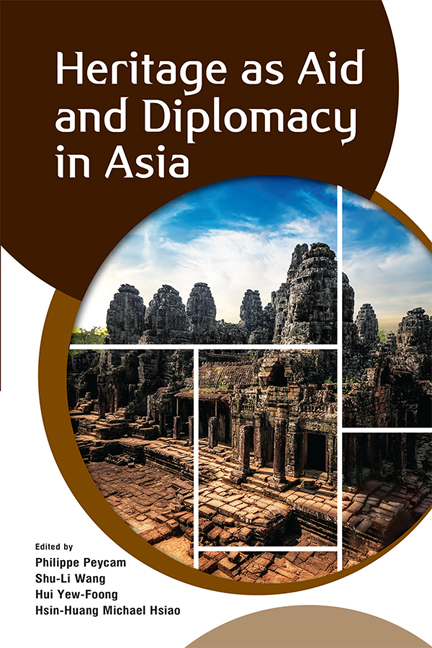Book contents
- Frontmatter
- Contents
- Contributors
- 1 Heritage as Aid and Diplomacy in Asia: An Introduction
- 2 World Heritage and WikiLeaks: Territory, Trade and Temples on the Thai-Cambodian Border
- 3 Heritage Making – Aid For Whom? The Genealogy of Expert Reports in the Hands of Politics and Their Impact in the Case of Preah Vihear
- 4 The International Coordinating Committee for Angkor: A World Heritage Site as an Arena of Competition, Connivance and State(s) Legitimation
- 5 Legacies of Cultural Philanthropy in Asia
- 6 To Help or Make Chaos? An Ethnography of Dutch Expertise in Postcolonial Indonesia
- 7 Heritage Conservation as a Tool for Cultural Diplomacy: Implications for the Sino-Japanese Relationship
- 8 From Ideological Alliance to Identity Clash: The Historical Origin of the Sino-Korean Goguryeo Controversies
- 9 Nationalism, Politics and the Practice of Archaeology in Afghanistan: A Case Study of Bamiyan
- 10 Disappearing Voices: The Politics and Practice of Safeguarding Kunqu Opera in the People’s Republic of China
- 11 Neoliberalizing Heritage: International Agencies and the Local Dynamics of Heritage Conservation in Bali, Indonesia
- 12 Heritage Conservation as Trickle-Down Development
- Index
12 - Heritage Conservation as Trickle-Down Development
Published online by Cambridge University Press: 10 November 2020
- Frontmatter
- Contents
- Contributors
- 1 Heritage as Aid and Diplomacy in Asia: An Introduction
- 2 World Heritage and WikiLeaks: Territory, Trade and Temples on the Thai-Cambodian Border
- 3 Heritage Making – Aid For Whom? The Genealogy of Expert Reports in the Hands of Politics and Their Impact in the Case of Preah Vihear
- 4 The International Coordinating Committee for Angkor: A World Heritage Site as an Arena of Competition, Connivance and State(s) Legitimation
- 5 Legacies of Cultural Philanthropy in Asia
- 6 To Help or Make Chaos? An Ethnography of Dutch Expertise in Postcolonial Indonesia
- 7 Heritage Conservation as a Tool for Cultural Diplomacy: Implications for the Sino-Japanese Relationship
- 8 From Ideological Alliance to Identity Clash: The Historical Origin of the Sino-Korean Goguryeo Controversies
- 9 Nationalism, Politics and the Practice of Archaeology in Afghanistan: A Case Study of Bamiyan
- 10 Disappearing Voices: The Politics and Practice of Safeguarding Kunqu Opera in the People’s Republic of China
- 11 Neoliberalizing Heritage: International Agencies and the Local Dynamics of Heritage Conservation in Bali, Indonesia
- 12 Heritage Conservation as Trickle-Down Development
- Index
Summary
Although the Union of Burma once tried to resist the grand vision of modernization and development with its associated machinery of Western lending and universalist discourses of technology transfer and democracy, the post-1988 governments of Myanmar have gradually adopted international standards as prescribed by the World Bank, the Asian Development Bank, ASEAN and others in order to catch up. They fear that if Myanmar does not become competitive in the regional economy, it will be swallowed up by China and India, and left behind by its ASEAN neighbours.
From 1962 to about 1988, the military-led socialist government drove out foreign influence and endeavoured to develop Burma on its own terms, to make it self-sufficient through The Burmese Way to Socialism. Although economic reform from about 1990 onward incrementally improved the national economy, Myanmar was still ill-prepared for integration into the ASEAN Economic Community because it could not compete as an equal. National reform initiated in 2011 has dramatically altered the status of the country on the world stage and opened the floodgates for international aid, but the country's long-term prospects remain uncertain. During the initial honeymoon-like phase between 2011 and 2016, sweeping changes seemed to indicate thorough reform in all sectors. However, the current phase under the leadership of Aung San Suu Kyi seems marked by economic stasis and increasing ethno-religious violence. In November 2015, the National League for Democracy (NLD) won the first openly contested general election since 1990, and came to power in March 2016. While the NLD and its leader, Aung San Suu Kyi, are broadly seen as symbols of hope and democracy, their symbolic significance has been tested by the complex reality of a country where ethno-religious violence continues unabated and basic needs in housing, education and health have yet to be met. It is too early to draw any conclusions, but for this discussion the exponential increase in the number of international actors in Myanmar has certainly increased the complexity of heritage-making and urban development and has unearthed entrenched and often contradictory practices that defy the rationale of linear international development.
- Type
- Chapter
- Information
- Heritage as Aid and Diplomacy in Asia , pp. 305 - 328Publisher: ISEAS–Yusof Ishak InstitutePrint publication year: 2020

